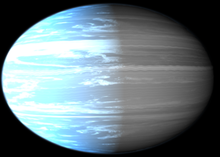

15th October 2022 (8 Topics)
Context
Recently, Scientists have detected barium in the upper atmosphere of two giant exo-planets for the first time. Barium, two and half times heavier than iron, is the heaviest-ever detected element.
What are Exoplanets?
- An exoplanet is any planet beyond our solar system. Most orbit other stars, but free-floating exoplanets, called rogue planets, orbit the galactic center and are untethered to any star.
- Most of the exoplanets discovered so far are in a relatively small region of our galaxy, the Milky Way. ("Small" means within thousands of light years of the solar system).
| Do you Know? Exoplanet Kepler-452b: Similar to Earth or (EARTH-like): NASA considers exoplanet Kepler-452b and its star to be the closest analog to our planet and Sun so far. Though it's 60% larger than Earth in diameter, Kepler-452b is thought to be rocky and within the habitable zone of a G-type star similar to ours. |
About
-
About the Study:
- The exoplanets that have been considered are two ultra-hot Jupiters— WASP-76b and WASP-121b — which orbit their host stars WASP 76 and WASP 121 (Named so as they have similar properties to Jupiter)
- They are about 640 light-years away and 900 light-years away from the Earth respectively.
- Both WASP-76b and WASP-121b complete one orbit in two days. Surface temperatures in these bodies reach as high as 1,000 degrees Celsius.
- These bodies have unique features owing to their high temperatures. For instance, WASP-76b experiences ‘iron rain’.
- They also confirmed the presence of hydrogen, lithium, sodium, magnesium, calcium, vanadium, chromium, manganese, and iron in the atmosphere of the WASP-76 b, in addition to barium.
- WASP-76b: The planet was discovered on October 21, 2013, and as of 2022 is the only known planet in its planetary system. It orbits its star at a distance of 0.033 AU with a period of 1.8 days. Its mass is 92 times that of Jupiter.
- WASP-121b: WASP-121b is an extrasolar planet orbiting the star WASP-121.
- WASP-121b is the first exoplanet found to contain water in an extrasolar planetary stratosphere

Properties of Barium:
- Appearance: Barium is a soft, silvery metal that rapidly tarnishes in the air and reacts with water.
- Occurrence: Barium occurs only in combination with other elements. The major ores are barite (barium sulfate) and witherite (barium carbonate). Barium metal can be prepared by electrolysis of molten barium chloride, or by heating barium oxide with aluminum powder.

- Uses:
- It is also used in paint and in glassmaking.
- All barium compounds are toxic; however, barium sulfate is insoluble and so can be safely swallowed. A suspension of barium sulfate is sometimes given to patients suffering from digestive disorders.
- Barium carbonate has been used in the past as a rat poison. Barium nitrate gives fireworks a green color.
- Barium has no known biological role, although barium sulfate has been found in one particular type of algae. Barium is toxic, as are its water- or acid-soluble compounds.
Why these metals are unique to be found in the Atmosphere?
- This discovery of barium is surprising because heavy elements like barium are expected to quickly fall (as these exoplanets have high gravity) into the lower layers of the atmosphere.
- It revealed some new dynamics inside the atmospheres or gives us insights into the composition of these distant planets.



